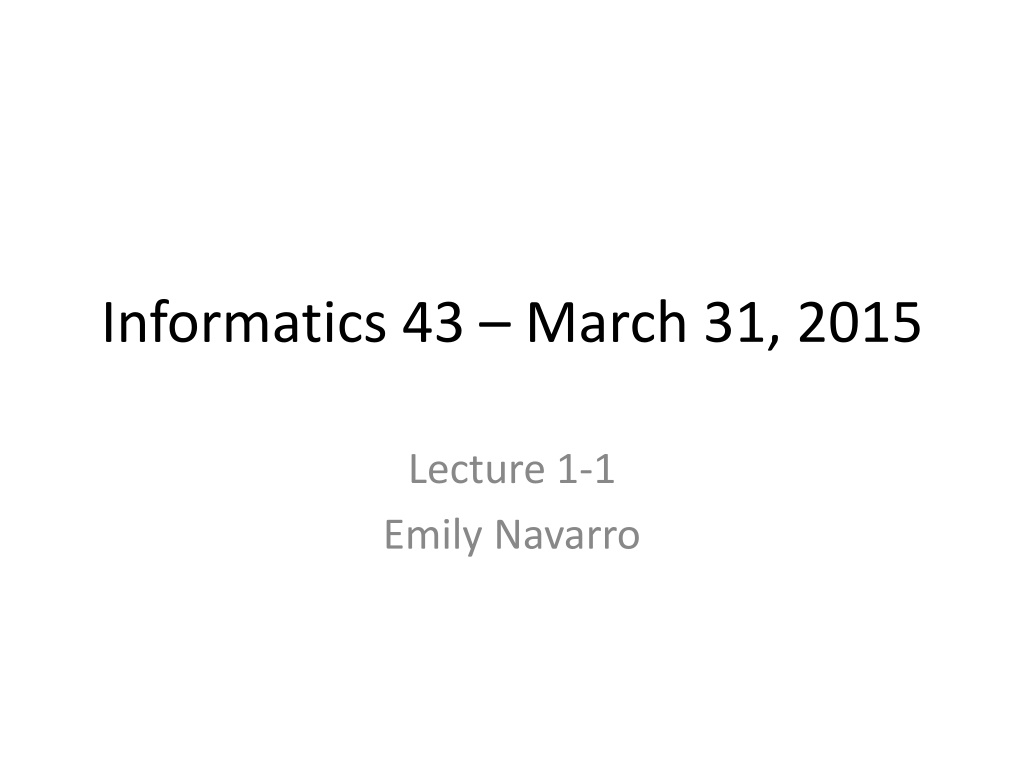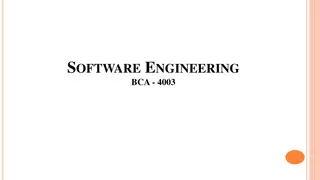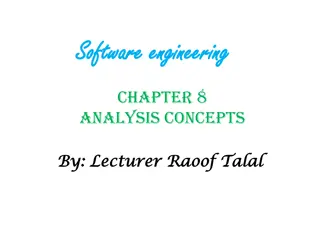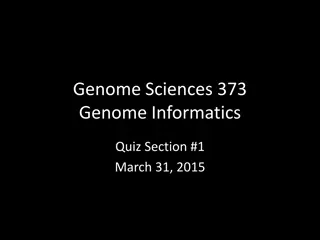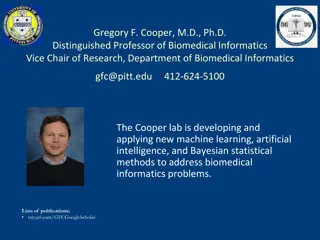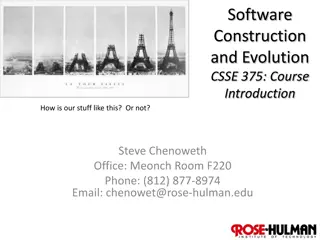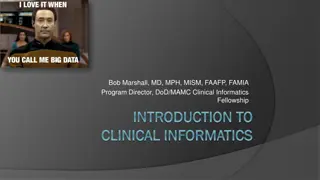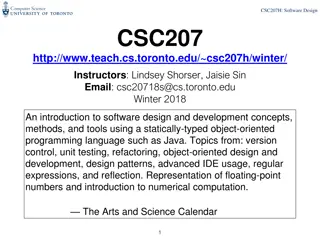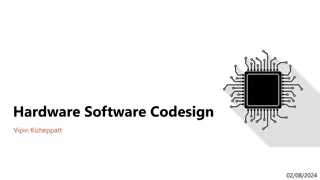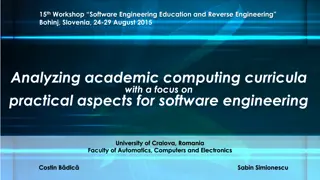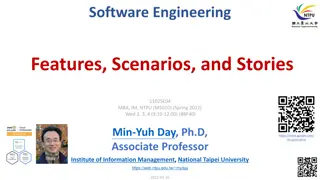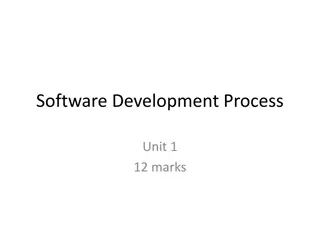Introduction to Software Engineering - INFORMATICS 43 Course Details
INFORMATICS 43 course on software engineering conducted by Professor Emily Navarro introduces students to the fundamentals of software development. The course covers various aspects of software engineering, including the importance of software in today's world, course structure, teaching staff details, office hours, quizzes schedule, grading criteria, and more. With a focus on practical learning and engagement, students will delve into key concepts and practices essential for a career in software engineering.
Download Presentation

Please find below an Image/Link to download the presentation.
The content on the website is provided AS IS for your information and personal use only. It may not be sold, licensed, or shared on other websites without obtaining consent from the author. Download presentation by click this link. If you encounter any issues during the download, it is possible that the publisher has removed the file from their server.
E N D
Presentation Transcript
Informatics 43 March 31, 2015 Lecture 1-1 Emily Navarro
Todays Lecture Course introduction Getting to know each other Introduction to software engineering Software is everywhere What is software engineering?
Todays Lecture Course introduction Getting to know each other Introduction to software engineering Software is everywhere What is software engineering?
Course Basics Course: Informatics 43 Introduction to Software Engineering Professor: Emily Navarro (emilyo@uci.edu) Lecture: T Th 5-6:20pm, EH 1200 Discussion: Fridays Starting in week 2 Course Website: http://www.ics.uci.edu/~emilyo/teaching/info43s 2015/index.html
Teaching Staff Professor: Emily Navarro TAs Swanand Pethe Anirudh Sethi Readers Isley Gao Cassie Jeansonne
Course Basics (II) My office hours Tuesdays 3:45-4:45 DBH 5221 TA office hours TBD Questions and announcements Piazza (https://piazza.com/uci/spring2015/in4matx43) Email or in class Class email list Required textbook Tsui, Karam, Bernal, "Essentials of Software Engineering," Third Edition
Quizzes 6 quizzes, most Thursdays (see schedule) Usually held from 6:05-6:20 Additional quizzes may be given without prior notice, and the time and length of the quizzes may change Quiz answers will be given orally, in class, each Tuesday after a quiz
Grading (I) Quizzes: 11% (total for all quizzes; each student's lowest quiz score will be dropped) Midterm: 25% Final: 25% Three homeworks: 36% (12% each) Class attendance and participation: 3% Submitting the EEE course evaluation: 0.5% extra credit
Grading (II) Performed by TA/reader and professor Resolve disagreements with the TA/reader first Keep up with the gradebook Do not come to me after the quarter is over with a discrepancy it will be too late
Cheating DON T DO IT!! Plagiarism = presenting someone else s work as your own All assignments are checked thoroughly for plagiarism Looking at someone else s paper during a quiz/test will be interpreted as cheating Plagiarism/cheating consequences Fail the course Offense recorded with Student Affairs
Late Work Late work will not be accepted Truly extenuating circumstances will be evaluated on a case-by-case basis Must provide official documentation (e.g., doctor s note) Exceptions only granted by the professor Contact professor as soon as possible Contact professor with valid reasons
Questions When in doubt ask the TA (or reader) ask the professor(s) E-mail questions answers are (generally) copied to everybody
Rules for Success in Info 43 (I) Attend every lecture Take notes Many quiz and test questions will be drawn from lecture material Attend every discussion It is your responsibility to make sure you sign the roll sheet in discussion Many quiz and test questions will be drawn from discussion assignments Complete the assigned readings Take notes Some quiz and test questions will be drawn from readings
Rules for Success in Info 43 (II) Check your UCI email daily Primary method of class announcements outside of lecture Work hard throughout the quarter Not just at the end!
Todays Lecture Course introduction Getting to know each other Introduction to software engineering Software is everywhere What is software engineering?
Who are you? What year of college is this for you?
Who are you? What is your major?
Who are you? How much do you love software engineering already?
Todays Lecture Course introduction Getting to know each other Introduction to software engineering Software is everywhere Definitions
Todays Lecture Course introduction Getting to know each other Introduction to software engineering Software is everywhere What is software engineering?
Software is everywhere: cars http://spectrum.ieee.org/green- tech/advanced-cars/this-car-runs-on-code/ New cars now frequently carry 200 pounds of electronics and more than a mile of wiring if you bought a premium-class automobile recently, it probably contains close to 100 million lines of software code
Software is everywhere: cars The radio on many cars talks to the automatic transmission over an in-car network The airbag accelerometer, parking lights, GPS navigation, cell phone, and door locks also network so that in a serious accident, the car calls for emergency aid, sends the GPS coordinates of the accident, unlocks the doors, and flashes the car s lights
Software is everywhere: medical systems
Software is everywhere: bonus The machine also connects to WiFi and has a camera for a QR scanner. They hope that some day, coffee bags will have a QR code that the machine will recognize and brew appropriately.
Todays Lecture Course introduction Getting to know each other Introduction to software engineering Software is everywhere What is software engineering?
What is Software Engineering? Software Engineering -
What is Software Engineering? Software Code Documentation, user manuals Designs, specifications Test cases Plans and schedules Engineering -
What is Software Engineering? Software Code Documentation, user manuals Designs, specifications Test cases Plans and schedules Engineering - Skill and knowledge Application of scientific principles Trade-offs, cost / benefit analysis
Software engineering A broad field that touches upon all aspects of developing and supporting a software system. [Tsui, Karam, Bernal]
Software engineering A broad field that touches upon all aspects of developing and supporting a software system. [Tsui, Karam, Bernal]
Software engineering A discipline that deals with the building of software systems which are so large that they are built by a team or teams of engineers. [Ghezzi, Jazayeri, Mandrioli]
Software engineering A discipline that deals with the building of software systems which are so large that they are built by a team or teams of engineers. [Ghezzi, Jazayeri, Mandrioli]
Software engineering Multi-person construction of multi-version software. [Parnas]
Software engineering Multi-person construction of multi-version software. [Parnas]
Software engineering A discipline whose aim is the production of fault-free software, delivered on-time and within budget, that satisfies the user s needs. Furthermore, the software must be easy to modify when the user s needs change. [Schach]
Software engineering A discipline whose aim is the production of fault-free software, delivered on-time and within budget, that satisfies the user s needs. Furthermore, the software must be easy to modify when the user s needs change. [Schach]
Software engineering Given a problem that can be addressed by a software solution, software engineering consists of the practices that manage the complexity of both the problem and the solution, to create a software product that successfully solves the problem. [Navarro]
Software engineering Given a problem that can be addressed by a software solution, software engineering consists of the practices that manage the complexity of both the problem and the solution, to create a software product that successfully solves the problem. [Navarro]
What is Software Engineering? Informatics 43: The process of constructing software. Phases of development other than programming. Principles and qualities of enduring value.
What is Software Engineering? Informatics 43: The process of constructing software. Phases of development other than programming. Principles and qualities of enduring value. Also of (lesser) interest (in this course): Managing & scheduling software development teams. Making money business models. Software s impact on users, organizations, and society.
What is Software Engineering? The process of constructing software.
What is Software Engineering? Phases of development other than programming. Design:
What is Software Engineering? Principles and qualities of enduring value. Correctness! Efficiency
Essential Characteristics of Software Engineering (I) Software engineering concerns the development of large programs The central theme is mastering complexity The efficiency with which software is developed is of crucial importance Software evolves
Essential Characteristics of Software Engineering (II) Regular cooperation between people is an integral part of programming-in-the-large The software has to support its users effectively Software engineering is a field in which members of one culture create artifacts on behalf of members of another culture Software engineering is a balancing act
Three Essential Ingredients of Software Engineering People who else would do the work? range from novice to very experienced Processes to organize and manage the efforts of individuals range from informal to very formal Tools to support the people and the processes range from simple to very advanced
People The single most important factor in the success/failure of a product Scarce resource quality suitability cost Many different kinds of people managers programmers technical writers
